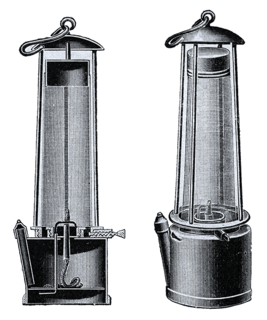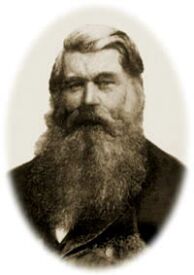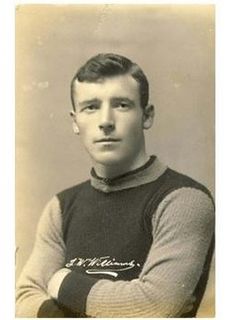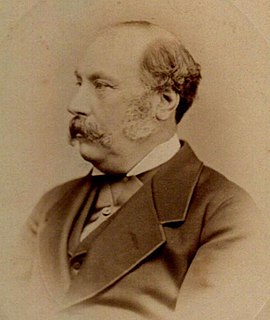Related Research Articles

Aberdare is a town in the Cynon Valley area of Rhondda Cynon Taf, Wales, at the confluence of the Rivers Dare (Dâr) and Cynon. Aberdare has a population of 14,462. Aberdare is 4 miles (6 km) south-west of Merthyr Tydfil, 20 miles (32 km) north-west of Cardiff and 22 miles (35 km) east-north-east of Swansea. During the 19th century it became a thriving industrial settlement, which was also notable for the vitality of its cultural life and as an important publishing centre.

The Davy lamp is a safety lamp for use in flammable atmospheres, invented in 1815 by Sir Humphry Davy. It consists of a wick lamp with the flame enclosed inside a mesh screen. It was created for use in coal mines, to reduce the danger of explosions due to the presence of methane and other flammable gases, called firedamp or minedamp.

Henry Austin Bruce, 1st Baron Aberdare, was a British Liberal Party politician, who served in government most notably as Home Secretary (1868–1873) and as Lord President of the Council.

Sir Joseph Wilson Swan FRS was an English physicist, chemist, and inventor. He is known as an independent early developer of a successful incandescent light bulb, and is the person responsible for developing and supplying the first incandescent lights used to illuminate homes and public buildings, including the Savoy Theatre, London, in 1881.

Lewis Howard Latimer was an American inventor and patent draftsman for the lightbulb and telephone.

Porth is a town and a community in the county borough of Rhondda Cynon Taf, within the historic county boundaries of Glamorgan, Wales, lying in the Rhondda Valley and is regarded as the gateway to the Rhondda Fawr and Rhondda Fach valleys because both valleys meet at Porth. The Welsh word "porth" means "gate". Porth is a predominantly English-speaking community.

Sir John Rhys, was a Welsh scholar, fellow of the British Academy, celticist and the first Professor of Celtic at Oxford University.

The Geordie lamp was a safety lamp for use in flammable atmospheres, invented by George Stephenson in 1815 as a miner's lamp to prevent explosions due to firedamp in coal mines.

Carbide lamps, or acetylene gas lamps, are simple lamps that produce and burn acetylene (C2H2) which is created by the reaction of calcium carbide (CaC2) with water (H2O).
A safety lamp is any of several types of lamp that provides illumination in coal mines and is designed to operate in air that may contain coal dust or gases both of which are potentially flammable or explosive. Until the development of effective electric lamps in the early 1900s miners used flame lamps to provide illumination. Open flame lamps could ignite flammable gases which collected in mines, causing explosions and so safety lamps were developed to enclose the flame and prevent it from igniting the surrounding atmosphere. Flame safety lamps have been replaced in mining with sealed explosion-proof electric lights.
William Reid Clanny FRSE was an Irish physician and inventor of a safety lamp.

Llwydcoed is a small village and community north of the Cwm Cynon, near the town of Aberdare, Rhondda Cynon Taf, Wales.

Clydach Vale is a village in the community of Cwm Clydach, northwest of Tonypandy in the county borough of Rhondda Cynon Taf, within the Rhondda Valley, Wales. It is named for its situation on the Nant Clydach, a tributary of the River Rhondda.
William Greener (1806–1869) was an English inventor and gunmaker. He developed a self-expanding bullet in 1835, an electric lamp in 1846 some 33 years before Thomas Edison's patent in 1879. William Greener also invented the percussion system for firing cannon, made improvements to the miner's safety lamp and won a prize for designing a mechanical device by which four gates at railway/road level crossings could be opened or closed simultaneously. He also invented a self-righting lifeboat, which was exhibited with a rocket gun and several of his famous percussion muzzle-loading shotguns and rifles at the Great Exhibition of 1851, where he was awarded a gold medal.

The South Wales Miners' Federation (SWMF), nicknamed "The Fed", was a trade union for coal miners in South Wales. It survives as the South Wales Area of the National Union of Mineworkers.
This article is about the particular significance of the year 1861 to Wales and its people.

John William Williams, also known as James Williams and referred to as "Ginger" Williams, was a Welsh professional footballer who won two caps for the Wales national football team and played in the Football League for Birmingham. He died on active service during the First World War.
The second election to the Glamorgan County Council was held on 8 March 1892. The 1889 election was the first contest and the next was the 1895 election. Glamorgan County Council had been established by the 1888 Local Government Act, and the first election held in January 1889. Glamorgan was by far the largest county in Wales in terms of population. The county of Glamorgan was at this time becoming heavily industrialised, although some areas such as the Vale of Glamorgan remained essentially rural. The rise of nonconformist liberalism, especially since the 1860s, throughout Wales, had challenged the prevailing influence of the landed gentry. However, even in 1889, the traditional forces remained influential and no working men were elected to the Council. This changed in 1892 with the unopposed return of David Morgan in Aberdare and the success of Isaac Evans in Resolven.
The Cambrian Miners' Association, also known as the Rhondda District Miners' Association, was an early trade union representing coal miners in the Rhondda Valley, in Wales.

James Harvey Insole was an English businessman who consolidated and developed the extensive South Wales coal mining and shipping business begun by his father George Insole.
References
- 1 2 Stephen R. Hughes (1994). Collieries of Wales: Engineering and Architecture. Royal Commission on the Ancient and Historical Monuments in Wales. p. 39. ISBN 978-1-871184-11-2.
- ↑ Patent office (1869). Chronological index of patents applied for and patents granted [afterw.] of patentees and applicants for patents of invention, by B. Woodcroft. pp. 17.
- ↑ James Washington Paul; Lee Clyde Ilsley; Ernest J. Gleim (1924). Flame Safety Lamps. U.S. Government Printing Office. pp. 18–24.
- ↑ Farm Implement & Machinery Review. Morgan-Grampian. 1878. p. 2038.
- ↑ International electric exhibition (1881). Crystal palace. International electric exhibition, 1881-82. Official catalogue, ed. by W. Grist. p. 85.
- ↑ The Electrical Engineer. Biggs & Company. 1903. p. 789.
- ↑ "Aberdare - Cambrian Lamp Works". Rhondda Cynon Taf Library Service. Retrieved 20 February 2020.
- ↑ "Site launch lights up mining past". BBC News Wales. 6 September 2001. Retrieved 20 February 2020.